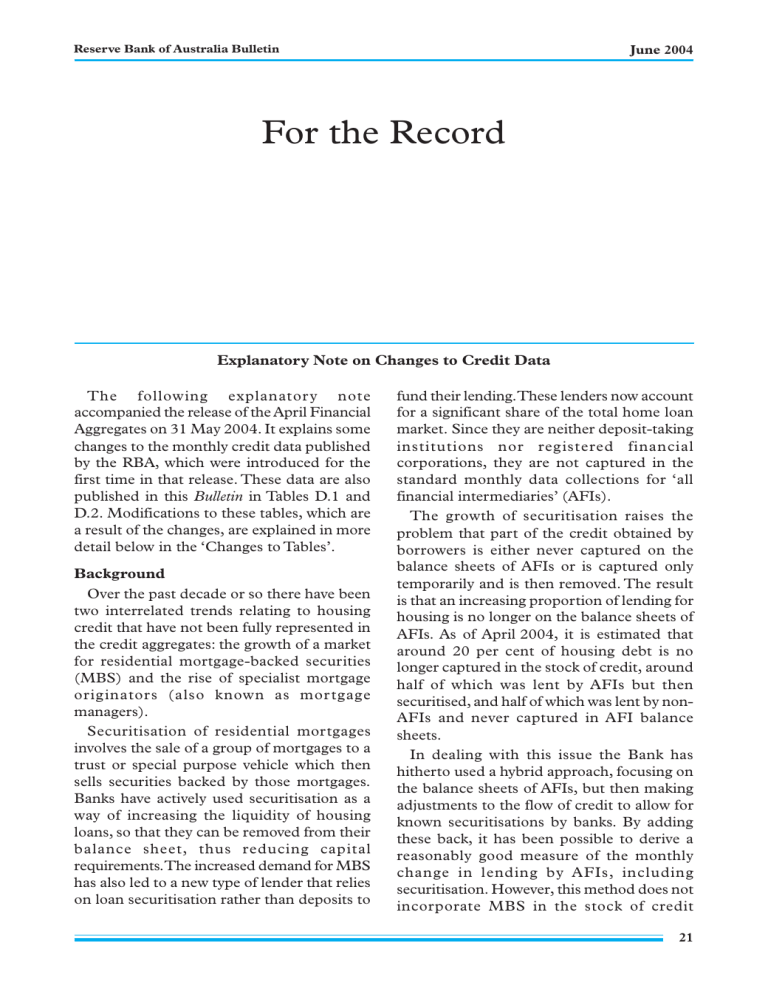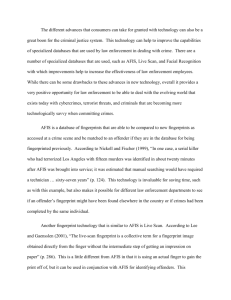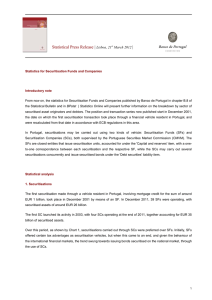For the Record

Reserve Bank of Australia Bulletin
For the Record
June 2004
Explanatory Note on Changes to Credit Data
The following explanator y note accompanied the release of the April Financial
Aggregates on 31 May 2004. It explains some changes to the monthly credit data published by the RBA, which were introduced for the first time in that release. These data are also published in this Bulletin in Tables D.1 and
D.2. Modifications to these tables, which are a result of the changes, are explained in more detail below in the ‘Changes to Tables’.
Background
Over the past decade or so there have been two interrelated trends relating to housing credit that have not been fully represented in the credit aggregates: the growth of a market for residential mortgage-backed securities
(MBS) and the rise of specialist mortgage orig inators (also known as mor tgage managers).
Securitisation of residential mortgages involves the sale of a group of mortgages to a trust or special purpose vehicle which then sells securities backed by those mortgages.
Banks have actively used securitisation as a way of increasing the liquidity of housing loans, so that they can be removed from their balance sheet, thus reducing capital requirements. The increased demand for MBS has also led to a new type of lender that relies on loan securitisation rather than deposits to fund their lending. These lenders now account for a significant share of the total home loan market. Since they are neither deposit-taking institutions nor reg istered financial corporations, they are not captured in the standard monthly data collections for ‘all financial intermediaries’ (AFIs).
The growth of securitisation raises the problem that part of the credit obtained by borrowers is either never captured on the balance sheets of AFIs or is captured only temporarily and is then removed. The result is that an increasing proportion of lending for housing is no longer on the balance sheets of
AFIs. As of April 2004, it is estimated that around 20 per cent of housing debt is no longer captured in the stock of credit, around half of which was lent by AFIs but then securitised, and half of which was lent by non-
AFIs and never captured in AFI balance sheets.
In dealing with this issue the Bank has hitherto used a hybrid approach, focusing on the balance sheets of AFIs, but then making adjustments to the flow of credit to allow for known securitisations by banks. By adding these back, it has been possible to derive a reasonably good measure of the monthly change in lending by AFIs, including securitisation. However, this method does not incorporate MBS in the stock of credit
21
For the Record outstanding and also does not allow the flow of repayments of securitised loans to be taken into account; these factors would tend to generate an overstatement of credit growth.
Working in the other direction, the traditional approach does not take into account the growth of lending by non-AFIs. Although the growth of this sector has been volatile, its lending has tended to grow faster than the lending of AFIs.
Until recently, these various effects had largely offset each other, but since around mid
2003 their net impact has boosted the measured growth rate of housing credit.
Accordingly, and based on the availability of improved data for dealing with the problems, the Bank is now revising its methodology for calculating credit data.
The new methodology
With this release, data on the level and g rowth of credit are being revised to incorporate an expanded definition of housing credit that includes a broad measure of the stock of residential MBS. This broader measure of housing credit is not based on the balance sheets of any particular group of institutions but is the sum of all measured housing debt , either on the balance sheet of
AFIs or incorporated in MBS. The data on housing loans on the balance sheets of AFIs will still be taken from their monthly reports.
Data on residential MBS will be taken from several sources, including ABS quarterly data on securitised housing debt and data on new securitisations collected from several market sources. The housing credit data will be seasonally adjusted by the Bank. The historical data have also been revised in accordance with the new definition.
The change in definition results in a downward revision to the estimate of household credit growth over the past year, although year-ended growth remains very rapid, at a rate of almost 20 per cent. Reflecting the revisions to household credit, total credit growth has also been revised downward, though by a smaller amount (see Graph 1).
However, business credit and the monetary aggregates are unaffected by this revision. The
Graph 1
June 2004
%
24
16
8
0
8
0
%
24
16
8
0
%
24
16
-8
1988 1992
Sources: ABS; RBA
Credit
Year-ended percentage change
Housing
%
Old
24
New
16
8
0
Household
Total
1996 2000
0
2004
-8
%
24
16
8
%
24
16
8
0 definitional change also does not affect previously reported estimates of household debt ratios, which already incorporated the full data on residential MBS.
The traditional data on the level of credit on the balance sheet of AFIs will still be published by the Bank, and will remain of interest for analysis of financial institutions.
However, for broader questions on the buildup of liabilities of the household sector, the expanded credit data will be of greater relevance.
The Bank will continue to monitor developments in the pattern of financing to both households and businesses. In the event of further structural changes, the Bank will make additional changes to the data compilation as are necessary to keep the data
22
Reserve Bank of Australia Bulletin relevant for analysis of the provision of financing. The Bank will also be seeking to improve data on MBS and possibly make adjustments to the securitisation flows of non-
June 2004
AFIs to better reflect the flow of lending by those institutions. This may result in additional revisions to the historical data over coming months.
23








